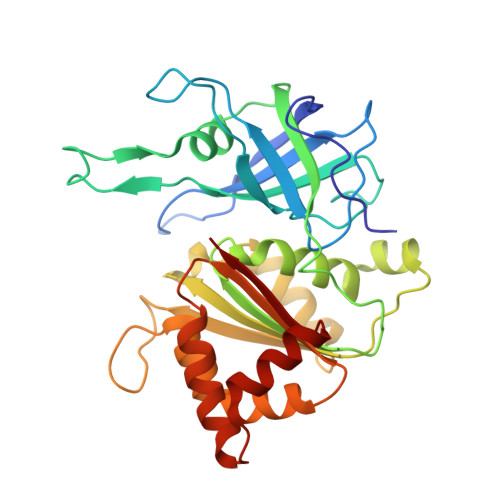Probing the determinants of coenzyme specificity in ferredoxin-NADP+ reductase by site-directed mutagenesis.
Medina, M., Luquita, A., Tejero, J., Hermoso, J., Mayoral, T., Sanz-Aparicio, J., Grever, K., Gomez-Moreno, C.(2001) J Biol Chem 276: 11902-11912
- PubMed: 11152461
- DOI: https://doi.org/10.1074/jbc.M009287200
- Primary Citation of Related Structures:
1BQE - PubMed Abstract:
On the basis of sequence and three-dimensional structure comparison between Anabaena PCC7119 ferredoxin-NADP(+) reductase (FNR) and other reductases from its structurally related family that bind either NADP(+)/H or NAD(+)/H, a set of amino acid residues that might determine the FNR coenzyme specificity can be assigned. These residues include Thr-155, Ser-223, Arg-224, Arg-233 and Tyr-235. Systematic replacement of these amino acids was done to identify which of them are the main determinants of coenzyme specificity. Our data indicate that all of the residues interacting with the 2'-phosphate of NADP(+)/H in Anabaena FNR are not involved to the same extent in determining coenzyme specificity and affinity. Thus, it is found that Ser-223 and Tyr-235 are important for determining NADP(+)/H specificity and orientation with respect to the protein, whereas Arg-224 and Arg-233 provide only secondary interactions in Anabaena FNR. The analysis of the T155G FNR form also indicates that the determinants of coenzyme specificity are not only situated in the 2'-phosphate NADP(+)/H interacting region but that other regions of the protein must be involved. These regions, although not interacting directly with the coenzyme, must produce specific structural arrangements of the backbone chain that determine coenzyme specificity. The loop formed by residues 261-268 in Anabaena FNR must be one of these regions.
Organizational Affiliation:
Departamento de Bioquimica y Biologia Molecular y Celular, Facultad de Ciencias, Universidad de Zaragoza, 50009 Zaragoza, Spain.
















